fuel Peugeot 508 RXH 2016 Owner's Manual
[x] Cancel search | Manufacturer: PEUGEOT, Model Year: 2016, Model line: 508 RXH, Model: Peugeot 508 RXH 2016Pages: 364, PDF Size: 10.31 MB
Page 5 of 364
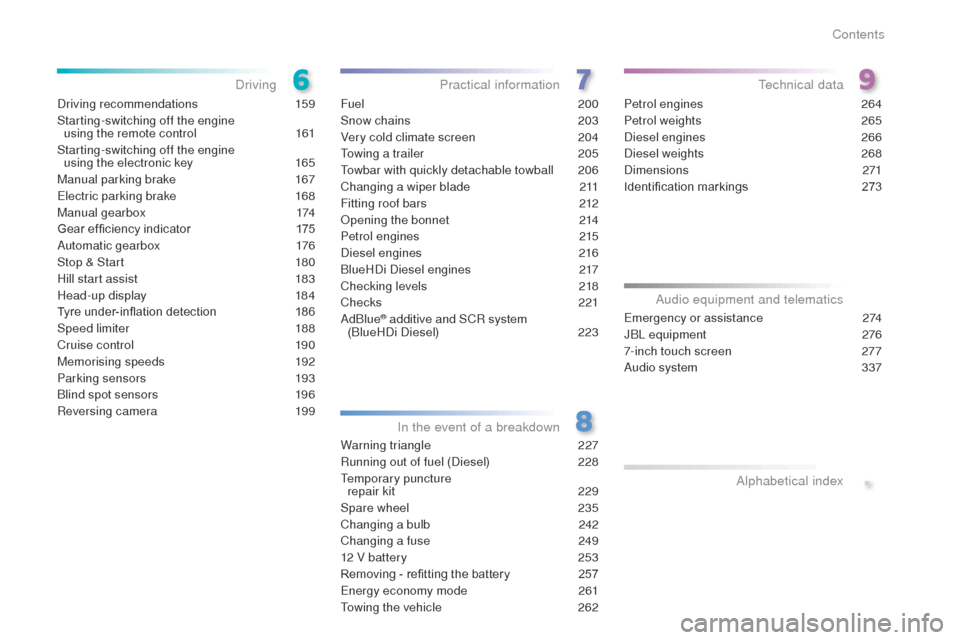
.
508_en_Chap00a_sommaire_ed01-2016
Driving recommendations 159
Starting-switching off the engine using the remote control
1
61
Starting-switching off the engine using the electronic key
1
65
Manual parking brake
1
67
el
ectric parking brake
1
68
Manual gearbox
1
74
Gear ef ficiency indicator
1
75
Automatic gearbox
1
76
Stop & Start
1
80
Hill start assist
1
83
Head-up display
1
84
Tyre under-inflation detection
1
86
Speed limiter
1
88
Cruise control
1
90
Memorising speeds
1
92
Parking sensors
1
93
Blind spot sensors
1
96
Reversing camera
1
99Fuel
200
Snow chains
2
03
Very cold climate screen
2
04
to
wing a trailer
2
05
to
wbar with quickly detachable towball
2
06
Changing a wiper blade
2
11
Fitting roof bars
2
12
Opening the bonnet
2
14
Petrol engines
2
15
Diesel engines
2
16
BlueHDi Diesel engines
2
17
Checking levels
2
18
Checks
221
AdBlue
® additive and SCR system
(BlueHDi Diesel) 2 23
Warning triangle
2
27
Running out of fuel (Diesel)
2
28
te
mporary puncture
repair kit
2
29
Spare wheel
23
5
Changing a bulb
2
42
Changing a fuse
2
49
12 V battery
2
53
Removing - refitting the battery
2
57
en
ergy economy mode
26
1
to
wing the vehicle
2
62Petrol engines
2
64
Petrol weights
2
65
Diesel engines
2
66
Diesel weights
26
8
Dimensions
271
Identification markings
2
73em
ergency or assistance 2 74
JBL equipment 2 76
7-inch touch screen
2
77
Audio system
3
37
DrivingPractical information
In the event of a breakdownte chnical data
Audio equipment and telematics Alphabetical index
Contents
Page 6 of 364
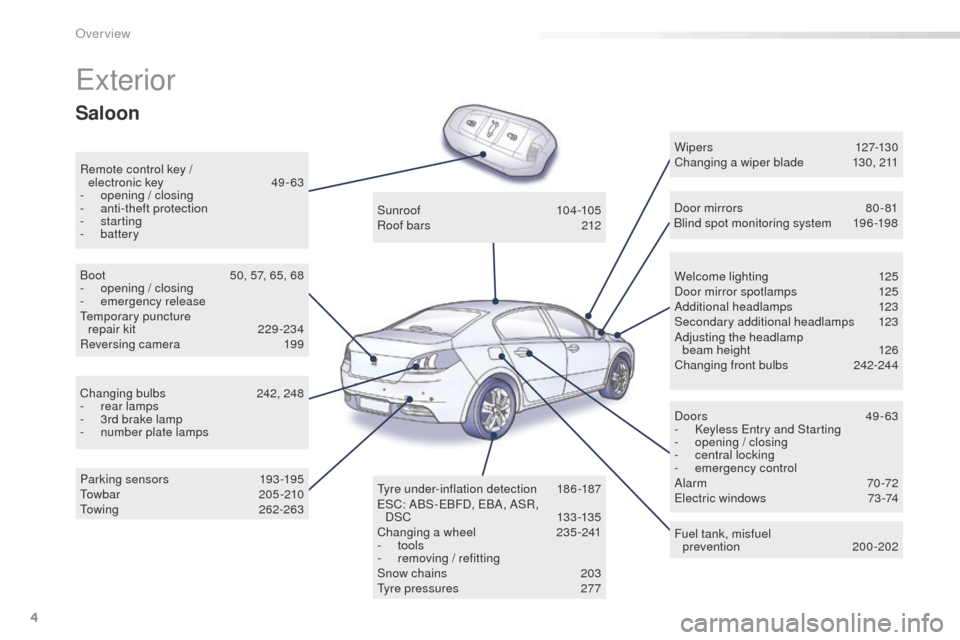
4
508_en_Chap00b_vue-ensemble_ed01-2016
exterior
Remote control key / electronic key 49 -63
-
ope
ning / closing
-
a
nti-theft protection
-
starting
-
battery Welcome lighting
1
25
Door mirror spotlamps
1
25
Additional headlamps
1
23
Secondary additional headlamps
1
23
Adjusting the headlamp beam height
1
26
Changing front bulbs
2
42-244
W i p e r s
127-13 0
Changing a wiper blade 1 30, 211
Doors
4
9 - 63
-
K
eyless e
n
try and Starting
-
ope
ning / closing
-
c
entral locking
-
em
ergency control
Alarm
7
0-72
el
ectric windows
7
3 -74
Fuel tank, misfuel prevention
200-202
Sunroof
10
4 -105
Roof bars
2
12
ty
re under-inflation detection
1
86 -187
e
SC: ABS-
eB
FD, e
B
A, ASR,
DSC
13 3 -13 5
Changing a wheel
2
35-241
-
tools
-
r
emoving / refitting
Snow chains
2
03
ty
re pressures
2
77
Boot
5
0, 57, 65, 68
-
ope
ning / closing
-
em
ergency release
te
mporary puncture
repair kit
2
29-234
Reversing camera
1
99
Changing bulbs
2
42, 248
-
r
ear lamps
-
3
rd brake lamp
-
n
umber plate lamps
Parking sensors
1
93-195
to
w b a r
2 0 5 - 2 10
to
wing
262-263 Door mirrors
8
0 - 81
Blind spot monitoring system
1
96 -198
Saloon
Over view
Page 7 of 364
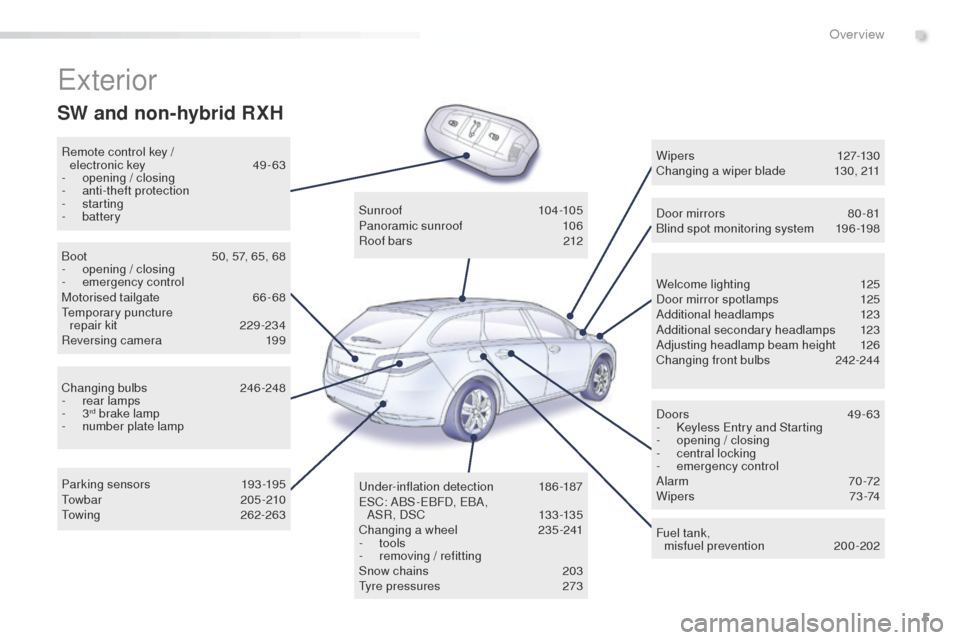
5
508_en_Chap00b_vue-ensemble_ed01-2016
exterior
Remote control key / electronic key 49 -63
-
ope
ning / closing
-
a
nti-theft protection
-
starting
-
battery
Welcome lighting
1
25
Door mirror spotlamps
1
25
Additional headlamps
1
23
Additional secondary headlamps
1
23
Adjusting headlamp beam height
1
26
Changing front bulbs
2
42-244
W i p e r s
127-13 0
Changing a wiper blade
1
30, 211
Door mirrors
8
0 - 81
Blind spot monitoring system
1
96 -198
Doors
4
9 - 63
-
K
eyless e
n
try and Starting
-
ope
ning / closing
-
c
entral locking
-
em
ergency control
Alarm
7
0-72
W i p e r s
7 3 -74
Fuel tank, misfuel prevention
2
00-202
Boot
5
0, 57, 65, 68
-
ope
ning / closing
-
em
ergency control
Motorised tailgate
6
6- 68
te
mporary puncture
repair kit
2
29-234
Reversing camera
1
99
Changing bulbs
2
46-248
-
r
ear lamps
-
3
rd brake lamp
-
n
umber plate lamp
Parking sensors
1
93-195
to
w b a r
2 0 5 - 2 10
to
wing
262-263Sunroof
10
4 -105
Panoramic sunroof
1
06
Roof bars
2
12
un
der-inflation detection
1
86-187
e
SC: ABS-
eB
FD, e
B
A,
AS R , DSC
13
3 -13 5
Changing a wheel
2
35-241
-
tools
-
r
emoving / refitting
Snow chains
2
03
ty
re pressures
2
73
SW and non-hybrid RXH
.
Over view
Page 11 of 364
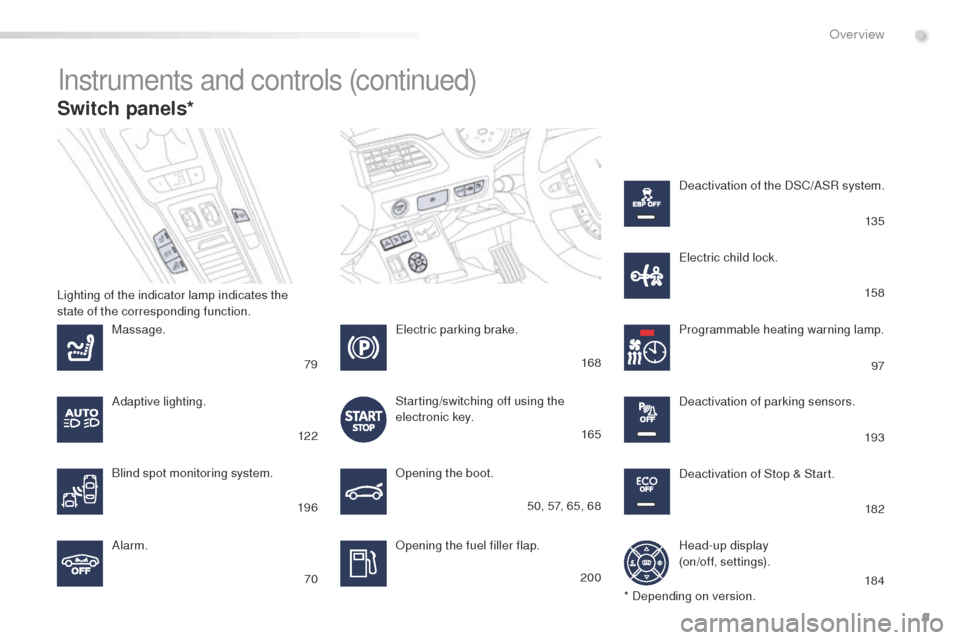
9
508_en_Chap00b_vue-ensemble_ed01-2016
Switch panels*
Instruments and controls (continued)
Opening the boot.
Opening the fuel filler flap.
Massage.
Alarm. Programmable heating warning lamp.
el
ectric parking brake.
Starting/switching off using the
electronic key. Deactivation of Stop & Start.
Head-up display
(on/off, settings). Deactivation of parking sensors.
Blind spot monitoring system.
el
ectric child lock.
Deactivation of the DSC/ASR system.
Adaptive lighting.
Lighting of the indicator lamp indicates the
state of the corresponding function.
* Depending on version.
70
79
12 2
19 6 200168
165
50, 57, 65, 68
18 497
193 182 13 5
15 8
.
Over view
Page 12 of 364
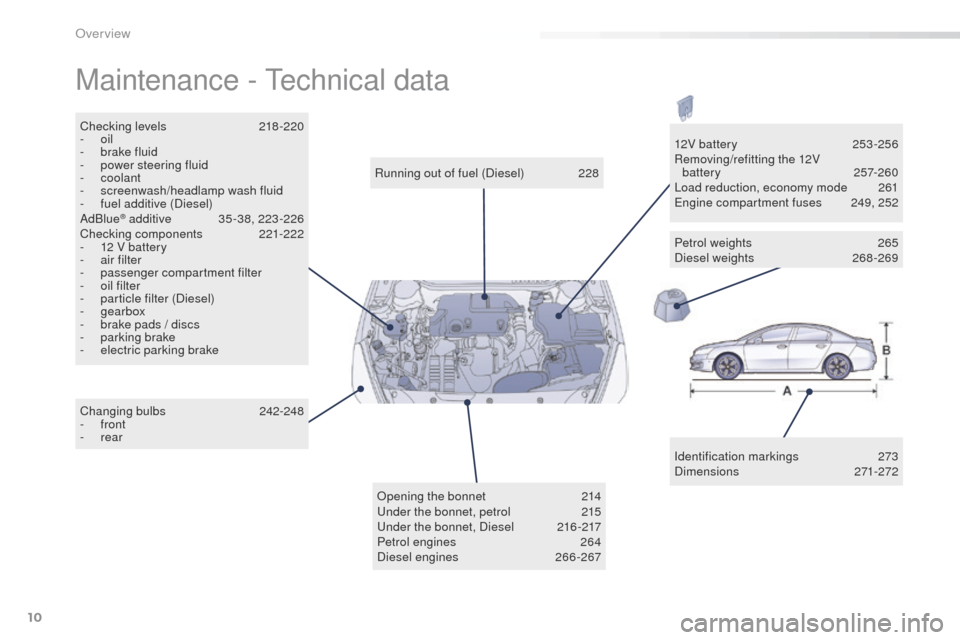
10
508_en_Chap00b_vue-ensemble_ed01-2016
Maintenance - technical data
Identification markings 2 73
Dimensions 271-272
Running out of fuel (Diesel)
2
28
Checking levels
2
18-220
-
oil
-
b
rake fluid
-
p
ower steering fluid
-
coolant
-
s
creenwash/headlamp wash fluid
-
f
uel additive (Diesel)
AdBlue
® additive 3 5-38, 223-226
Checking components 2 21-222
-
1
2 V battery
-
a
ir filter
-
p
assenger compartment filter
-
o
il filter
-
p
article filter (Diesel)
-
gearbox
-
b
rake pads / discs
-
par
king brake
-
e
lectric parking brake
Changing bulbs
2
42-248
-
front
-
rear 12V battery
2
53 -256
Removing/refitting the 12V battery
257-260
Load reduction, economy mode
26
1
en
gine compartment fuses
2
49, 252
Opening the bonnet
2
14
un
der the bonnet, petrol
2
15
un
der the bonnet, Diesel
2
16 -217
Petrol engines
2
64
Diesel engines
26
6-267Petrol weights
2
65
Diesel weights
26
8-269
Over view
Page 13 of 364
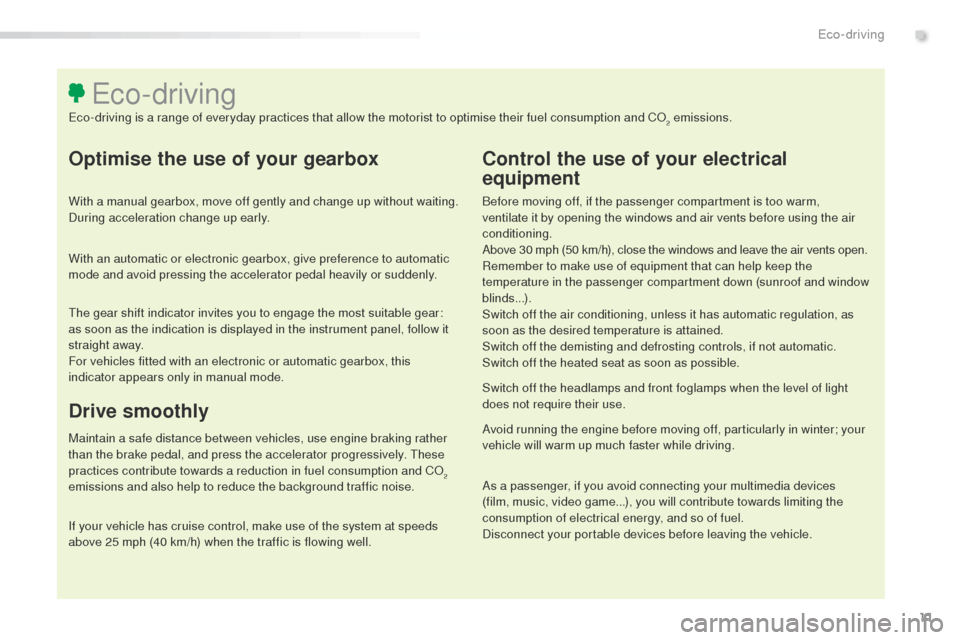
11
508_en_Chap00c_eco-conduite_ed01-2016
Optimise the use of your gearbox
With a manual gearbox, move off gently and change up without waiting.
During acceleration change up early.
With an automatic or electronic gearbox, give preference to automatic
mode and avoid pressing the accelerator pedal heavily or suddenly.
Control the use of your electrical
equipment
Before moving off, if the passenger compartment is too warm,
ventilate it by opening the windows and air vents before using the air
conditioning.
Above 30 mph (50 km/h), close the windows and leave the air vents open.
Remember to make use of equipment that can help keep the
temperature in the passenger compartment down (sunroof and window
blinds...).
Switch off the air conditioning, unless it has automatic regulation, as
soon as the desired temperature is attained.
Switch off the demisting and defrosting controls, if not automatic.
Switch off the heated seat as soon as possible.
Switch off the headlamps and front foglamps when the level of light
does not require their use.
Avoid running the engine before moving off, particularly in winter; your
vehicle will warm up much faster while driving.
As a passenger, if you avoid connecting your multimedia devices
(film, music, video game...), you will contribute towards limiting the
consumption of electrical energy, and so of fuel.
Disconnect your portable devices before leaving the vehicle.
eco-driving
eco-driving is a range of everyday practices that allow the motorist to optimise their fuel consumption and CO2 emissions.
Drive smoothly
Maintain a safe distance between vehicles, use engine braking rather
than the brake pedal, and press the accelerator progressively. th ese
practices contribute towards a reduction in fuel consumption and CO
2
emissions and also help to reduce the background traffic noise.
If your vehicle has cruise control, make use of the system at speeds
above 25 mph (40 km/h) when the traffic is flowing well.
th
e gear shift indicator invites you to engage the most suitable gear:
as soon as the indication is displayed in the instrument panel, follow it
straight away.
For vehicles fitted with an electronic or automatic gearbox, this
indicator appears only in manual mode.
.
eco-driving
Page 14 of 364
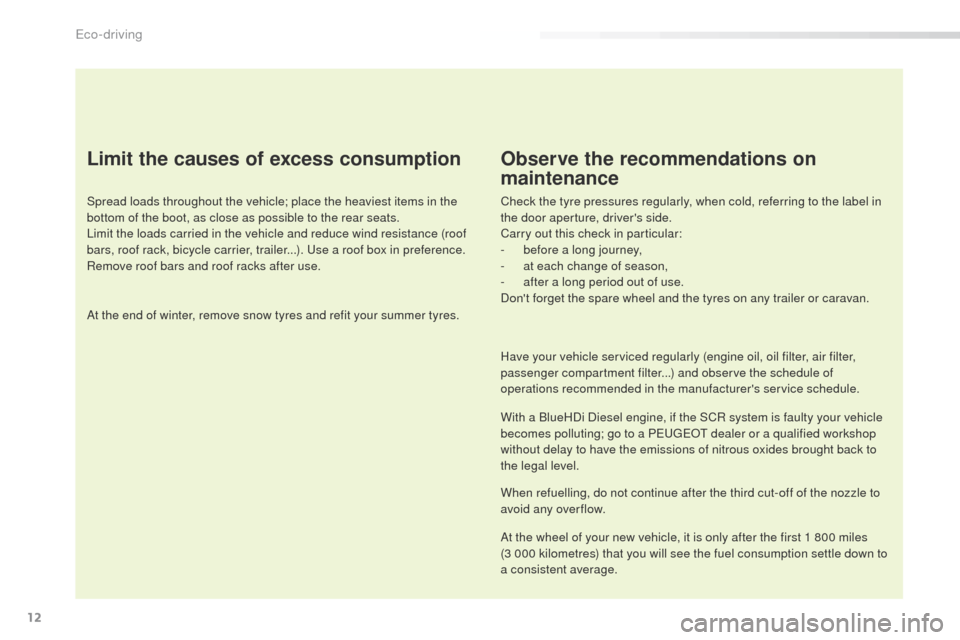
12
508_en_Chap00c_eco-conduite_ed01-2016
Limit the causes of excess consumption
Spread loads throughout the vehicle; place the heaviest items in the
bottom of the boot, as close as possible to the rear seats.
Limit the loads carried in the vehicle and reduce wind resistance (roof
bars, roof rack, bicycle carrier, trailer...). u
s
e a roof box in preference.
Remove roof bars and roof racks after use.
At the end of winter, remove snow tyres and refit your summer tyres.
Observe the recommendations on
maintenance
Check the tyre pressures regularly, when cold, referring to the label in
the door aperture, driver's side.
Carry out this check in particular:
-
b
efore a long journey,
-
a
t each change of season,
-
a
fter a long period out of use.
Don't forget the spare wheel and the tyres on any trailer or caravan.
Have your vehicle serviced regularly (engine oil, oil filter, air filter,
passenger compartment filter...) and observe the schedule of
operations recommended in the manufacturer's service schedule.
With a BlueHDi Diesel engine, if the SCR system is faulty your vehicle
becomes polluting; go to a P
e
uge
Ot
dealer or a qualified workshop
without delay to have the emissions of nitrous oxides brought back to
the legal level.
When refuelling, do not continue after the third cut-off of the nozzle to
avoid any over flow.
At the wheel of your new vehicle, it is only after the first 1 800 miles
(3
000 kilometres) that you will see the fuel consumption settle down to
a consistent average.
eco-driving
Page 25 of 364
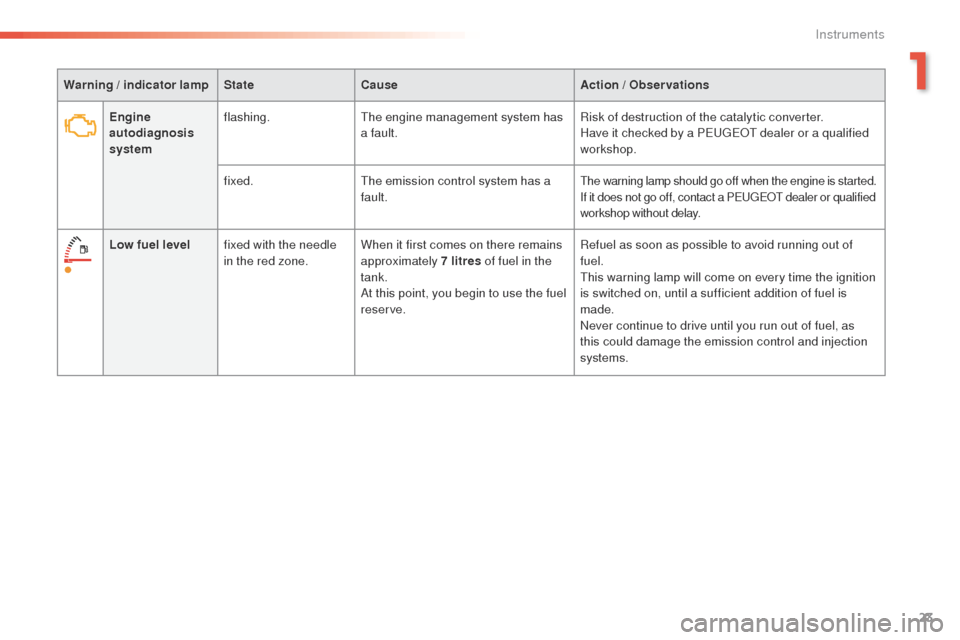
23
508 _en_Chap01_instrument-bord_ed01-2016
Warning / indicator lampStateCause Action / Observations
Engine
autodiagnosis
system flashing.
the
engine management system has
a fault. Risk of destruction of the catalytic converter.
Have it checked by a P
e
uge
Ot
dealer or a qualified
workshop.
fixed.
th
e emission control system has a
fault.
the warning lamp should go off when the engine is started.
If it does not go off, contact a Pe ugeOt dealer or qualified
workshop without delay.
Low fuel level fixed with the needle
in the red zone. When it first comes on there remains
approximately 7 litres of fuel in the
tank.
At this point, you begin to use the fuel
reserve. Refuel as soon as possible to avoid running out of
fuel.
th
is warning lamp will come on every time the ignition
is switched on, until a sufficient addition of fuel is
made.
Never continue to drive until you run out of fuel, as
this could damage the emission control and injection
systems.
1
Instruments
Page 30 of 364
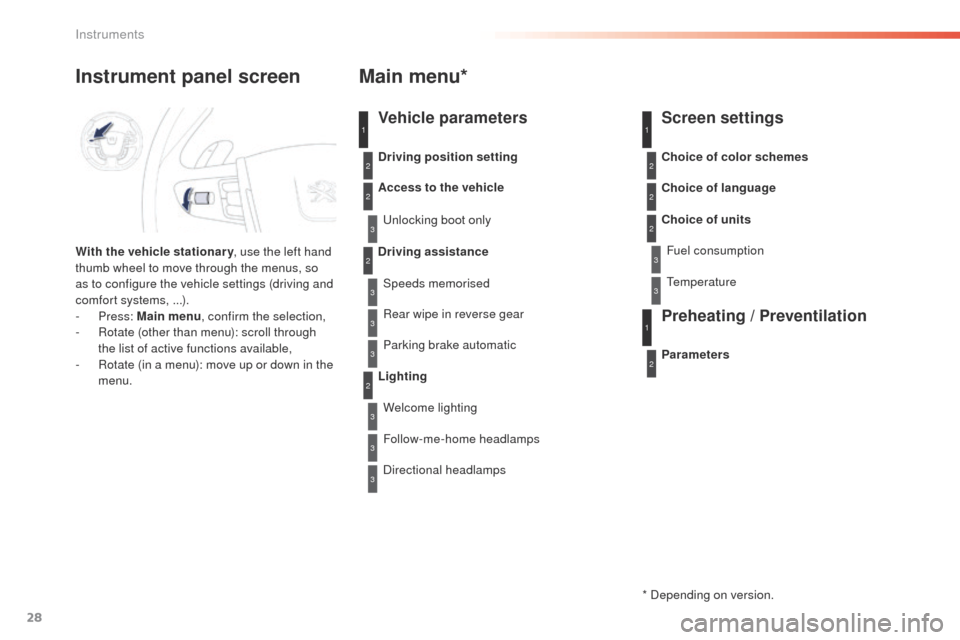
28
508 _en_Chap01_instrument-bord_ed01-2016
1
2
2
2
2
3
3
3
3
3
3
3
Instrument panel screen
With the vehicle stationary, use the left hand
thumb wheel to move through the menus, so
as to configure the vehicle settings (driving and
comfort systems, ...).
-
Press: Main menu , confirm the selection,
-
R
otate (other than menu): scroll through
the list of active functions available,
-
R
otate (in a menu): move up or down in the
menu.
Main menu*
Vehicle parameters Screen settings
Preheating / Preventilation
Driving position setting
Access to the vehicle
unl
ocking boot only
Driving assistance Speeds memorised
Rear wipe in reverse gear
Parking brake automatic
Lighting Welcome lighting
Follow-me-home headlamps
Directional headlamps Parameters Choice of color schemes
Choice of language
Choice of units
Fuel consumption
1
2
2
2
3
3
1
2
* Depending on version.
te
mperature
Instruments
Page 41 of 364
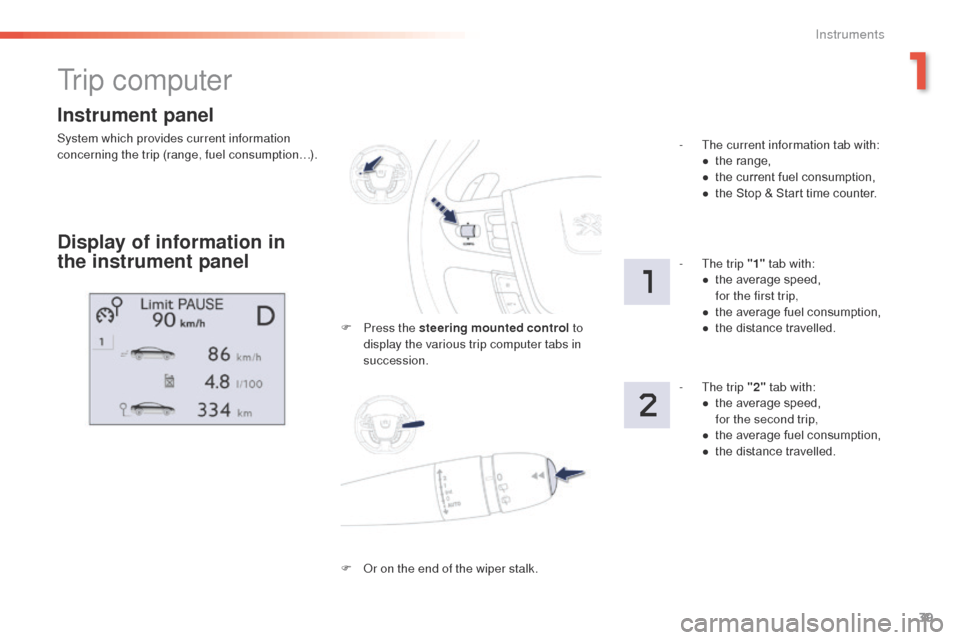
39
508 _en_Chap01_instrument-bord_ed01-2016
Instrument panel
System which provides current information
concerning the trip (range, fuel consumption…).
tr i p c o m p u t e r
Display of information in
the instrument panel
F Press the steering mounted control to
display the various trip computer tabs in
succession. -
t
h
e current information tab with:
●
t
he range,
●
t
he current fuel consumption,
●
t
he Stop & Start time counter.
- t
h
e trip "1"
tab with:
●
t
he average speed,
f
or the first trip,
●
t
he average fuel consumption,
● t he distance travelled.
- t
h
e trip "2" tab with:
●
t
he average speed,
f
or the second trip,
●
t
he average fuel consumption,
●
t
he distance travelled.
F
O
r on the end of the wiper stalk.
1
Instruments